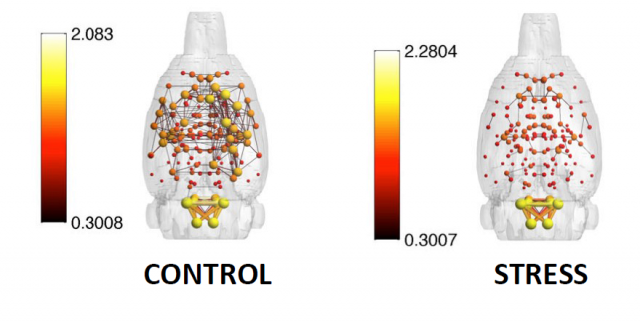Early life social stress has long-term impact on brain networks in rats

Investigators in veterinary and human medicine have uncovered long-term changes in the brains of adult female rats exposed to social stresses early in life, with the biggest impact on regions of the brain that are linked to social behavior, stress, emotion and depression. The findings, which appear online in advance of the January 2017 print edition of Behavioural Brain Research, establish a neural foundation for related imaging work in humans and animals and will enable researchers to begin testing preventative measures and treatments for depression and anxiety.
A team led by Benjamin Nephew, assistant professor at Cummings School of Veterinary Medicine at Tufts University, studied adult female rats exposed to early life chronic social stress (ECSS). Using an ECSS model that was established in Nephew's previous research on postpartum depression and anxiety, the female rats in the test group were exposed to social stress in their first two weeks of life as pups, while the control group was not exposed to social stress. Previous studies looking at animal models of depression and anxiety have focused primarily on males. The current research can provide important insight into the development of these psychiatric disorders in females.
When the rats reached adulthood (65-90 days old), functional magnetic resonance imaging (fMRI) was administered to measure resting state functional connectivity—the fluctuation in activity in different regions of the brain.
Analysis of the imaging from the ECSS group showed broad changes in activity in areas of the brain that control, among other things, rewards, social behavior, stress and depression. This study was the first to measure resting state functional connectivity in conscious rats in a model of depression. Using fMRI enabled researchers to identify changes in multiple neural circuits simultaneously.
"Conscious rodent imaging allows us to make significant comparisons with human work, as well as integrate past rodent work that focused on individual nuclei to make conclusions about neural networks that control behavior," said Nephew, the paper's corresponding author.
"Comparing the data from the imaging with clinical models can enhance understanding of susceptibility, resilience, pathological origin and treatment response," added Dr. Jean King, an author on the study and director of the Center for Comparative NeuroImaging at University of Massachusetts Medical School.
"We can now begin to test preventative measures and treatments for depression and anxiety—some of which may be unique to females—and assess how they affect both behavior and neural activity in several of the networks that were most affected by social stress in this study," Nephew concluded.
More information: Benjamin C. Nephew et al. Altered neural connectivity in adult female rats exposed to early life social stress, Behavioural Brain Research (2017). DOI: 10.1016/j.bbr.2016.08.051
















